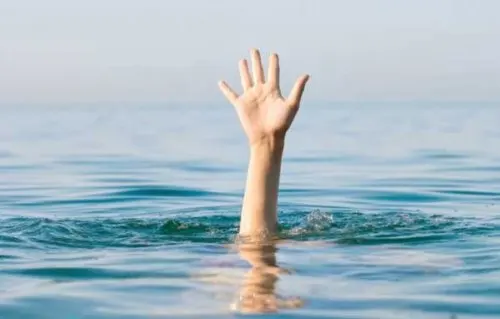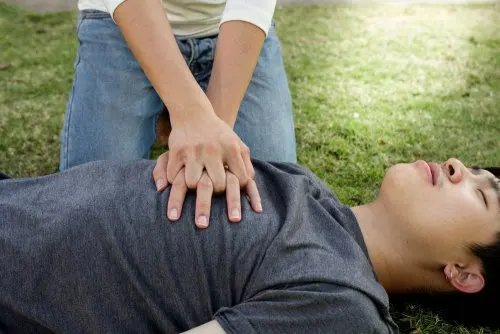Would You Know How to Act if Someone is Drowning?


Reviewed and approved by the doctor Nelton Abdon Ramos Rojas
Having basic first aid knowledge is very useful because it allows you to know how to act in emergency situations, such as if someone is drowning. If you don’t know the basic steps you would have to take if you find yourself in this situation, don’t hesitate and take note of them because at some point they may end up being very useful.
It’s not that accidents in the water are very common, but in the desperation of the moment, when they do happen, we often don’t know how to react in the case of seeing that a person is drowning.
Drowning is caused by the sudden irruption of water in the lungs. This prevents the entry of air, which causes suffocation and can lead to death.
The first steps if someone is drowning

The first thing to do is to try to get the person out of the water without putting yourself in danger. If you know how to swim and it is safe, go to the person and try to “pull” him or her in such a position that at least his or her face (especially nose and mouth) is at the surface and face up. Ideally, use any object that is capable of floating.
The victim should be placed in an area that allows for proper support. If you don’t know what to do, it’s necessary to ask for help from other people and call the fire department, rescuers, or emergency services.
Once you have clarified this point, you will have to check if the victim is breathing. You will have to check whether his or her chest rises and falls. You can also feel their breathing by bringing your cheek close to his or her mouth. If the person is breathing normally, put them in a lateral position to prevent them from choking if they start vomiting.
It’s important that you don’t try to remove water from their lungs or make them vomit. Go for help first. If you were to practice mouth-to-mouth breathing, you should know that it consists of passing the fresh air contained in your airway into the other person’s lungs.
Mouth-to-mouth breathing is something that can be done regardless of the victim’s age. However, this technique should only be initiated if the drowning person is unconscious and is determined not to be breathing. To do it correctly, just follow these steps:
- Lay the affected person face up on the floor or on a solid surface.
- Tilt their forehead back with one hand and lower their chin with the other hand to open their mouth and airway.
- Take a deep breath of air and hold your nose with your index finger and thumb.
- Expel air into the patient’s mouth for 2 seconds.
- Withdraw and wait 5 seconds to repeat the process.
If the maneuver is successful, the drowning person should begin to cough up the inspired water. At this moment, it will be necessary to place him/her on his/her side to prevent the liquid from returning to the lungs.
We think you may also enjoy reading this article: First Aid Treatment for Carbon Monoxide Poisoning
First aid for children

If the victim is a child and you have to give mouth-to-mouth resuscitation, you will have to tilt the child’s head backward so that their tongue does not block the air passage. Then you will have to blow into the child’s mouth, squeezing the child’s nose. In this way, you will be performing the insufflation correctly.
In this sense, the best recommendation is to always keep an eye on children and that they remain under the supervision of an adult. In addition, if you entrust this task to another child or a teenager, both could be more easily distracted and it’s likely that they have neither the necessary physical capacity for rescue nor sufficient preparation to perform first aid.
Meanwhile, if this maneuver is necessary, it’s best to check that the victim’s chest is inflated slightly, without excess. The frequency should be 15 to 20 breaths per minute. If it’s a baby, place both the baby’s nose and mouth inside your mouth and then blow and follow the steps mentioned above.
It’s always important to remember that children’s lungs are smaller and have a smaller capacity than those of adults. In this sense, it’s important to exhale the air slowly into the baby’s lungs and to verify that it’s not too much. All these measures will prevent the occurrence of possible injuries.
Cardiopulmonary resuscitation

If you have to do cardiopulmonary resuscitation (CPR), you will have to know how to perform it correctly. So keep the following indications in mind:
- This consists of compressing the heart to maintain blood circulation: while doing this, you must alternate mouth-to-mouth breathing and chest compression.
- Before starting, you should check that the person who is choking is unconscious, is not breathing, and has no pulse. If the patient is breathing or has a pulse, do not start CPR under any circumstances.
- If the victim is less than one year old, the cycle is two breaths and 30 compressions at a rate of 100 compressions per minute. Keep in mind that the bones of young children and infants are weaker, so compressions should only be performed with just two fingers.
- If the person older than one year of age, the correct cycle is 30 chest compressions at a rate of 120 compressions per minute followed by 2 breaths. Compressions in the adult should be performed by interlocking both hands and dropping the body weight until the chest sinks approximately 5 centimeters.
- A complete cycle consists of giving 30 compressions along with 2 breaths, ideally, 4 cycles should be completed before resuscitation can be stopped.
- On the other hand, if you don’t have help or adequate physical condition, it’s best not to perform the breathing. This activity can fatigue you and make the compressions ineffective.
The most important thing is to call for help or call emergency services quickly. If you are accompanied, ask someone else to get help while you practice first aid. If there’s no one else, continue to perform first aid techniques because they can be vital for the victim.
Even if the victim reacts, you must accompany him/her and be attentive to the symptoms he/she may present; breathing may stop again and it is essential that he/she is not left alone in those moments.
Like this article? You may also like to read: First Aid in Case of Accidental Finger Amputation
Don’t forget to check for hypothermia
Treat the drowning person for hypothermia; if you can, remove wet clothing and cover the person with dry blankets. If the drowning person regains full consciousness, offer them a warm drink. Sometimes this gesture is almost enough to make the patient better.
As you can see, first aid when someone is drowning can mean the difference between life and death. The most important thing in this type of situation is to remain calm and act in a calm and serene manner, following all the steps mentioned.
In addition, it should be noted that if you don’t know the proper technique to perform any of the maneuvers we have described, you should call emergency services before acting. Performing chest compressions or mouth-to-mouth breathing improperly may cause further damage.
All cited sources were thoroughly reviewed by our team to ensure their quality, reliability, currency, and validity. The bibliography of this article was considered reliable and of academic or scientific accuracy.
-
Peláez, T. U. M. I., & Cordeiro, I. (2006). Manual De Primeros Auxilios. Universidad Nacional Autonoma De Mexico. https://doi.org/10.1016/S0304-4858(05)74508-X.
-
Grau Enrique. (2010). Primeros auxilios. Apuntes Primeros Auxilios 2010 TAFA. https://doi.org/10.1016/S0305-0491(96)00325-2.
-
Koningsloo, E. F. Van. (2007). Primeros auxilios ¿porqué aprenderlos? Cruz Roja Española.
-
Sala Sanjaume, J., Betbesé Roig, A., Pérez Márquez, M., García San Pedro, A., Desola Alá, J., la Santa Creu Sant Pau Barcelona, D., & Desola CRIS-UTH DosdeMaig, J. (2001). Preahogamiento Guía de Actuación. Apunts Medicina de L´Esport. https://doi.org/10.1016/S1886-6581(00)75980-9.
This text is provided for informational purposes only and does not replace consultation with a professional. If in doubt, consult your specialist.








